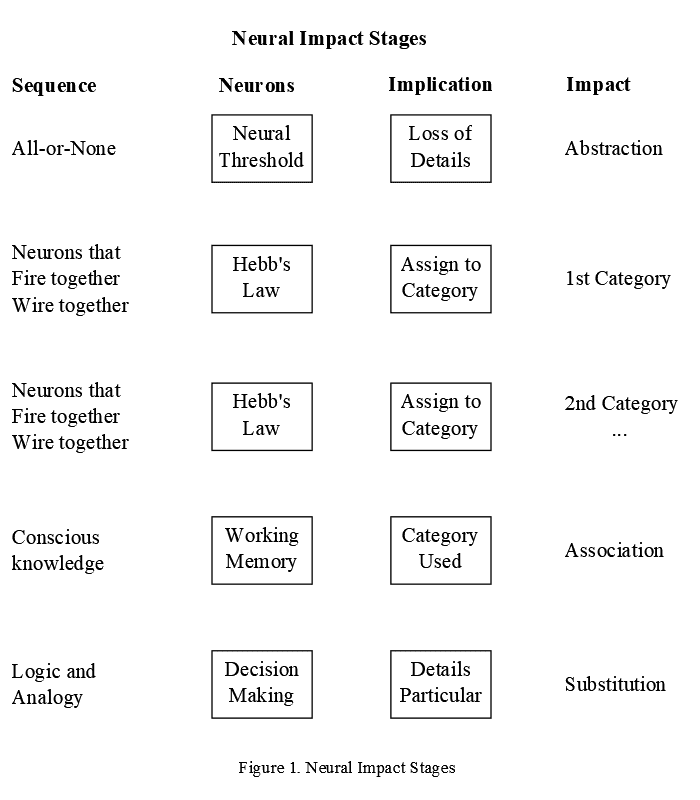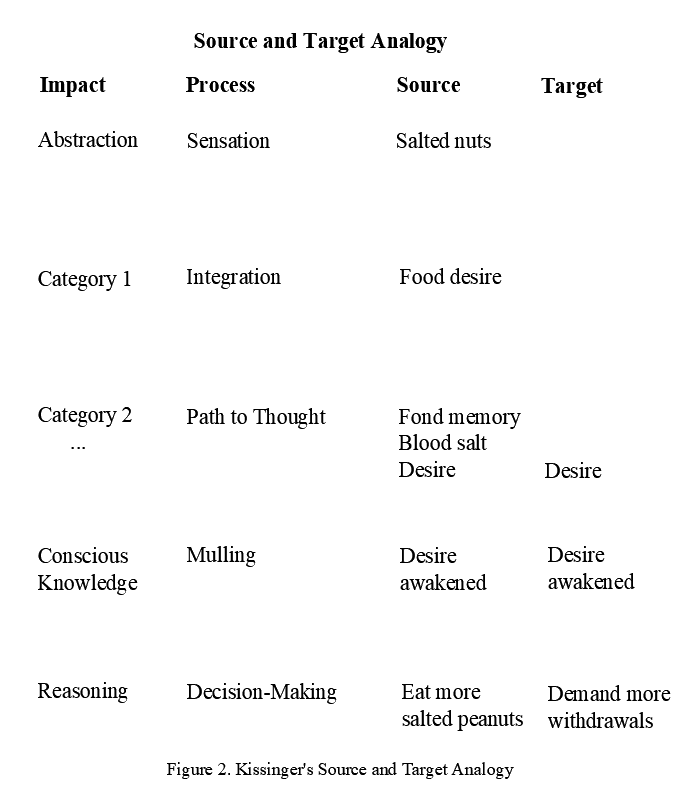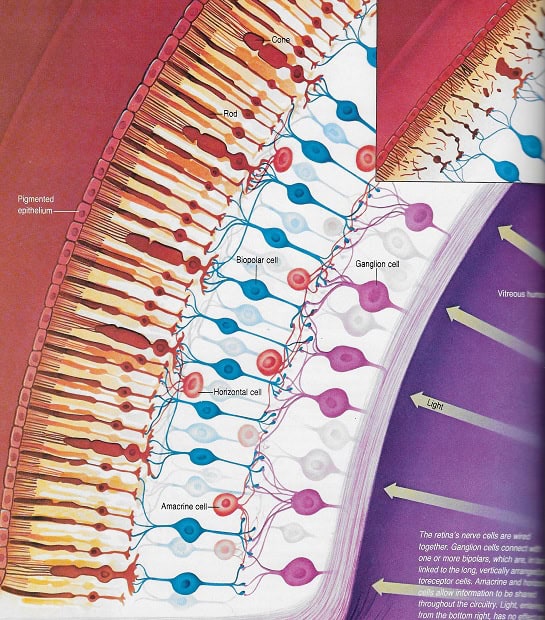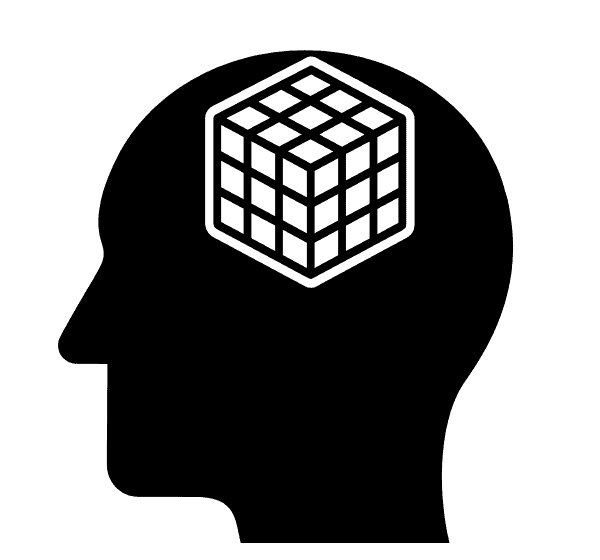Reasoning by Analogy
“Withdrawal of U.S. troops will become like salted peanuts to the American public; the more U.S. troops come home, the more will be demanded.” – Henry Kissinger in a Memo to President Richard Nixon.
This striking example of reasoning by analogy argues against troop withdrawal by linking it to a common human feeling when eating salted peanuts. How and why might we be swayed by analogical reasoning (the formal term for reasoning by analogy)?
The bare structure of the reasoning has three components.
- Source Idea: Eating salted peanuts awakens a desire. People want another.
- Implied General Trait: The initial satisfaction increases the likelihood of subsequent requests.
- Application to Target Idea: The first troop withdraw will awaken the desire for more troop withdrawals.
Analogical Interpretation
A more general structure of this analogical reasoning is:
- Premise 1: Source A has trait {trait1} among others. Source A leads to result {result1}.
- Salted peanuts eaten taste good {trait1}
- Leading to desire for more {result1}
- Premise 2: Target B shares traits {trait1}.
- Withdrawal of troops {trait1} feels good.
- Conclusion: Therefore, Target B leads to desire for more. {result1}.
This argument form is inductive, also called ampliative. Since the conclusion is a generalization, it is not guaranteed to be true even if the premises are.
Thus, relying on analogical reasoning requires careful evaluation. We must ensure that the similarities are relevant and sufficient, and that the differences we ignore are not significant or impactful.
How does analogical reasoning arise in the brain? What is the neurological basis for associating results from similar, but not exact, situations?
Neural Mechanism
Our brain automatically groups sensory inputs into categories with shared features. This occurs due to the combination of the neuron’s All-or-None firing and Hebb’s observation that neurons that fire together, wire together. These two features allow the grouping of similar inputs into the same category. A side effect is that any detail beyond what is necessary to fire the neuron gets ignored.
Let’s consider the processing steps of sensory data in Figure 1. Neural Impact Stages.

The left column in Figure 1 lists the sequence of neural events that occur with an event.
- Sensation Recognition: This relies on the All-or-None firing of neurons, which send signals from one neuron to others.
- Integration of Sensory Information: This process depends on the principle that neurons that fire together, wire together. This regularity helps group similar inputs into the same category.
- Information Pathway: Information is passed along neural pathways towards our prefrontal lobes for processing. These are more integration steps, again relying on the principle that neurons that fire together, wire together.
- Augmented Sensory Information: This arrives in the executive areas of the prefrontal lobes, ready for further processing.
- Decision-Making: This final step requires reasoning based on logic and analogies.
The next column to the left, Neurons, lists the neural properties used on the row.
- Neural Threshold: The neural threshold property of neurons governs whether a neuron sends a signal. If the sum of its inputs is less than the threshold, no signal is sent. If the sum is equal to or greater than the threshold, the neuron sends a signal through its axon. Importantly, the signal is the same whether the threshold is barely exceeded or greatly exceeded.
- Hebb’s Theory: Hebb’s theory states that repeated firing of the same neurons leads to those same neurons firing in unison in the future. This theory is not restricted to sensory neurons; it applies across all neural pathways in the brain.
- Working Memory: Neurons in working memory have developed specialized, collaborative features. Besides handling verbal categories, working memory handles individualized patterns and can exchange those words and patterns.
- Specialized Neural Modules: Some neural modules have specialized their inherent associations through categories to handle verbal categories with logic.
The Implications column mentions the main impact of the neural property active at each stage.
- The loss of details references the All-or-None signal property, which transmits only that a neuron has fired. Information about which inputs to the neuron caused it to signal is lost. Downstream neurons do not know the details of upstream activity, only the result.
- Losing detail implies that multiple input sensations result in the same signal. This grouping of all these inputs forms a category.
- As signals travel through neural pathways, they are passed forward when neural thresholds are exceeded. As the signals continue towards the prefrontal executive areas, further categorization takes place as memories, knowledge, and 3S biological imperatives (Satiety, Sex, and Safety) are merged with the original sensory data.
- Sensory inputs have multiple categories by the time they arrive in our consciousness. These multiple categories provide various associations (interpretations) of the impact of the sensory event on us.
- Rational considerations of our reaction to an event can be iterative, switching between substituting abstract categories, searching for the most optimal response.
The last column, Impact, lists common terms that capture each stage.
- Abstraction: The loss of detail.
- 1st Category: Abstraction leads to multiple sensory experiences sharing most features being cast into the same category.
- 2nd Category: Integrating an existing category along neural pathways leads to a second category of higher abstraction and further additional categories of higher abstraction (greater generality, lesser detail).
- Association: Any memory within the same category is available.
- Substitution: To determine if it offers a better response to the situation, we consider another memory with different details.
Analogy Source. Salted Peanuts
With that background, we can discuss how a salted peanuts observation leaped to troop withdraw caution in Figure 2. Kissinger’s Source and Target Analogy.

The leftmost column in Figure 2 identifies the neural impact on the Process column that specifies the processing performed. The third column displays the content of the analogy source. The rightmost column displays the target content.
From the first row, we see that abstraction occurs in sensory processing, resulting in awareness that salted peanuts are tasted.
In the second row, the person forms category 1 {trait1} by recognizing the taste based on their prior experiences.
In the third row, an assignment to a further abstracted category—such as favorite level of salt, or a special fondness due perhaps to a favorite relative who always had salted peanuts, or merely a substance that would quiet the rumbling of a hungry stomach. There are multiple steps as the sensation continues its path to conscious awareness. This results in multiple categories associated with the sensation.
In the fourth row, we are aware of the sensation with its various categories. For the analogy source, Kissinger has selected the desire category.
In the bottom most row, cause-and-effect decision-making led Kissinger to conclude that the eating the salted peanut will cause a person to want another salted peanut. He ignored any evidence to the contrary that would clutter his point.
Analogy Target. Withdrawal Impact
In Figure 2, the first three rows in the fourth column are blank. The analogy starts at a higher level of abstraction than actual physical reality.
In the fourth row, in a person’s conscious awareness, Kissinger claimed a direct link between salted peanuts and troop withdrawal, although they differ in many details.
In the last row, during decision-making, the analogy asserts the consequence of withdrawing troops will be a desire for more troops to be withdrawn, because of the analogical relationship.
Considerations for Relying Reasoning by Analogy
The three missing entries in the fourth column of Figure 2 reveal the large scope of potential differences ignored when asserting the analogy.
Several crucial rules, courtesy Stanford Encyclopedia of Philosophy, for evaluating analogical reasoning are:
- The more similarities (between two domains), the stronger the analogy.
- The more differences, the weaker the analogy.
- The greater the extent of our ignorance about the two domains, the weaker the analogy.
Widespread Use and Reliance on Reasoning by Analogy
Reasoning by analogy is bolstered by three neural features: neural threshold for sending a signal, the All-or-None nature of signals, and Hebb’s Law that neurons that fire-together, wire-together. However, neural support does not guarantee the truth or utility of the target conclusion, because the ignored differences may outweigh superficial similarities.
So, if the conclusion may be wrong, why do we ever use reasoning by analogy?
Because we often don’t have enough facts to complete a deductive argument. In Kissinger’s quote to Nixon, we saw that reasoning by analogy allowed Kissinger to jump over missing information to justify his caution about troop withdrawal.

But I don’t want to leave you believing that reasoning from analogy can’t be helpful. In 1609, Galileo drew an analogy between the visual effects of mountains on Earth and his telescopic observations on the Moon’s terminator. This led Galileo to declare there were mountains on the Moon, more than three and a half centuries ago.
Citation. Mountains on the Moon image created by Bing at my prompt.
Additional Information
Stanford Encyclopedia of Philosophy article on Analogy and Analogical Reasoning.


